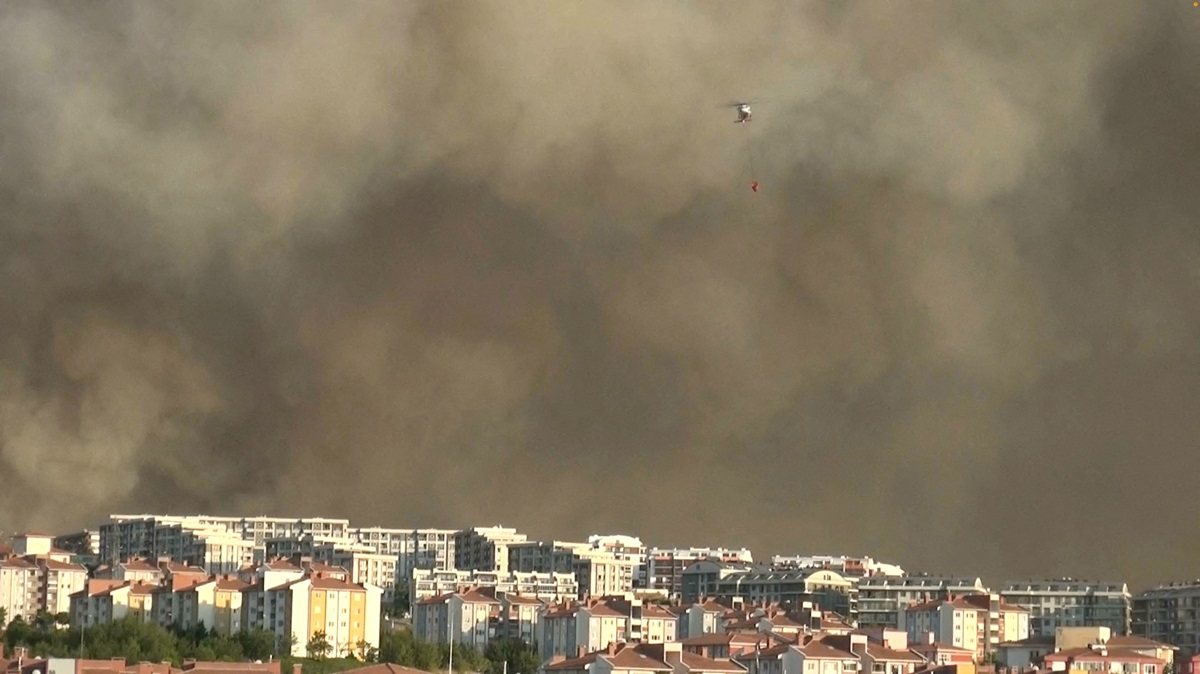
A helicopter carries a water bucket as a wildfire burns in Canakkale, Turkey, August 22, 2023, in this screen grab obtained from a social media video
17:07 JST, August 24, 2023
As some of the worst wildfires in modern history ravage parts of Canada and the United States this summer, scientists are eager to understand the effects of wildfire smoke on human health. Now, an alarming study has found that people living in areas with persistent exposure to wildfire smoke may have higher risks of developing dementia later in life.
In the western United States, there are regions where half of people’s annual exposure to fine particulate pollution is caused by wildfire smoke, said Sara Adar, an environmental epidemiologist at the University of Michigan and an author of the new study, published Aug. 14 in JAMA Internal Medicine.
“And we know that wildfire smoke is becoming more frequent and more severe,” she said.
Wildfires incinerate everything in their path, emitting a mixture of fine particles that may be more neurotoxic than particles originating elsewhere, added the study’s lead author, Boya Zhang, a research fellow in environmental epidemiology at the University of Michigan.
It is scientifically well-known that inhaling microscopic particles floating in the air can cause a host of serious health problems. Scientists are most concerned about particles known as PM2.5, which are less than 2.5 micrometers wide (the width of a human hair ranges from 50 to 70 micrometers). These tiny particles can bypass our respiratory system’s defenses, enter the bloodstream and travel to vital organs, including the brain.
Particulate pollution has been associated with neurodegenerative diseases such as dementia, but whether specific PM2.5 sources are part of this link had not been thoroughly explored. The new study takes the next step by shedding light on how different particulate pollution sources can have varying levels of risk.
“I think this is the next direction we need to go in,” said Marc Weisskopf, an environmental epidemiologist at the Harvard T.H. Chan School of Public Health who was not involved in the study. “We need to know if there are certain [PM2.5] sources that really impact dementia so we can figure out what to regulate and where.”
Zhang and her team cognitively assessed nearly 30,000 Americans age 50 and older living throughout the country, using data collected between 1998 and 2018 for the federally funded Health and Retirement Study. None of the participants had dementia at the start of the study, and follow-ups were conducted every two years to track if there had been changes in their health.
To estimate the participants’ exposure levels, the scientists combined the health data with model estimates of PM2.5 from different sources, including agriculture, road traffic, industry, windblown dust and wildfires. They first simulated the total PM2.5 in the air and treated that as a baseline. Then, one by one, they turned off each source and subtracted the new estimate from the baseline to calculate the source-specific contribution.
To weed out other risk factors that could affect their results, Zhang and her collaborators accounted for characteristics in the study participants such as age, sex and race.
The researchers estimated that nearly 188,000 new cases of dementia every year were attributable to total PM2.5 exposure in the United States. After they adjusted for other risk factors, the team found that only wildfire smoke and agricultural emissions were linked to the disease.
The study found that PM2.5 emitted from agricultural activity had the highest concentrations in the Midwest. Toxic components of pesticides used in agriculture can bind with fine particulates in the area, such as windblown soil, and may harm human brains if inhaled, Zhang added.
“The entire way in which pesticides work is by being a neurotoxin to animals,” Adar said.
Scientists estimate that more than 7 million people in the United States had dementia in 2020. As the bulk of the population ages, the number of people with dementia is expected to rise to nearly 12 million in 2040.
The new study suggests that reduced exposure to wildfire smoke and agricultural emissions may help lower individual risk of developing the disease. However, more research is needed to confirm the findings.
“[For wildfires,] global action and policy are needed to slow down the pace of climate change,” Zhang said. “But on an individual level, during poor-air-quality days, it’s better to stay at home and not exercise outside. Also, maybe install an air purifier in your home, and shut your windows. If you have to go to work, wearing a mask is a better thing to do to protect yourself.”
"News Services" POPULAR ARTICLE
-

American Playwright Jeremy O. Harris Arrested in Japan on Alleged Drug Smuggling
-

Japan’s Nikkei Stock Average as JGB Yields, Yen Rise on Rate-Hike Bets
-

Japan’s Nikkei Stock Average Licks Wounds after Selloff Sparked by BOJ Hike Bets (UPDATE 1)
-

Japan’s Nikkei Stock Average Buoyed by Stable Yen; SoftBank’s Slide Caps Gains (UPDATE 1)
-

Japanese Bond Yields Zoom, Stocks Slide as Rate Hike Looms
JN ACCESS RANKING
-

Keidanren Chairman Yoshinobu Tsutsui Visits Kashiwazaki-Kariwa Nuclear Power Plant; Inspects New Emergency Safety System
-

Imports of Rare Earths from China Facing Delays, May Be Caused by Deterioration of Japan-China Relations
-

University of Tokyo Professor Discusses Japanese Economic Security in Interview Ahead of Forum
-

Japan Pulls out of Vietnam Nuclear Project, Complicating Hanoi’s Power Plans
-

Govt Aims to Expand NISA Program Lineup, Abolish Age Restriction





















